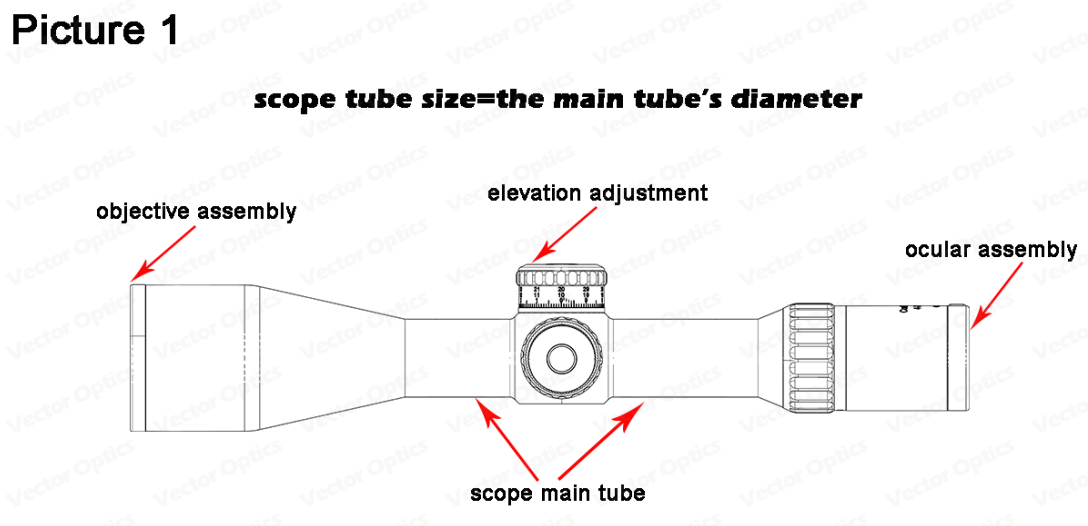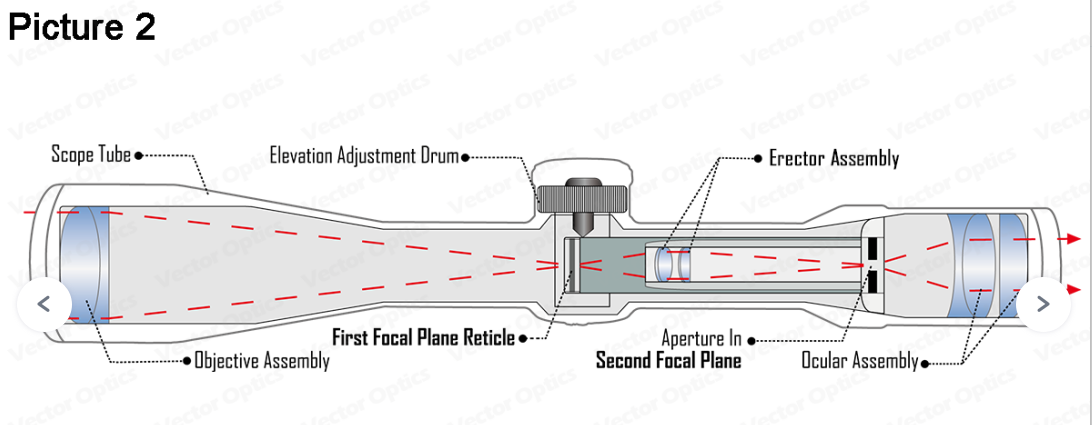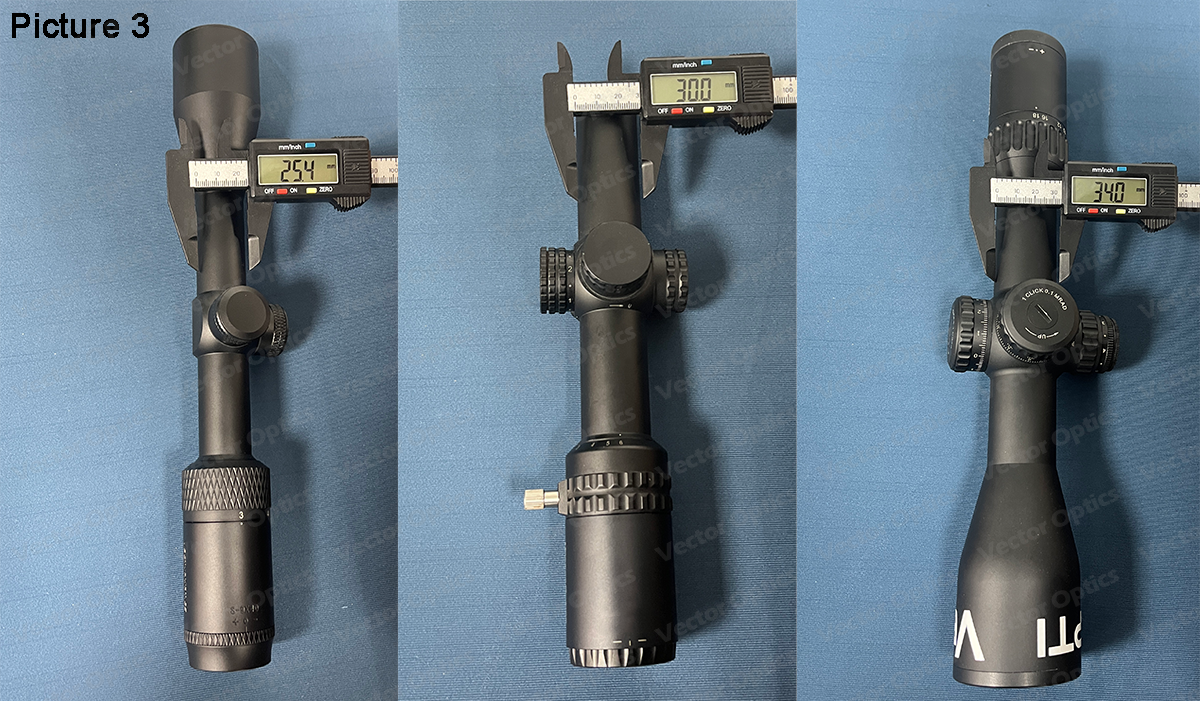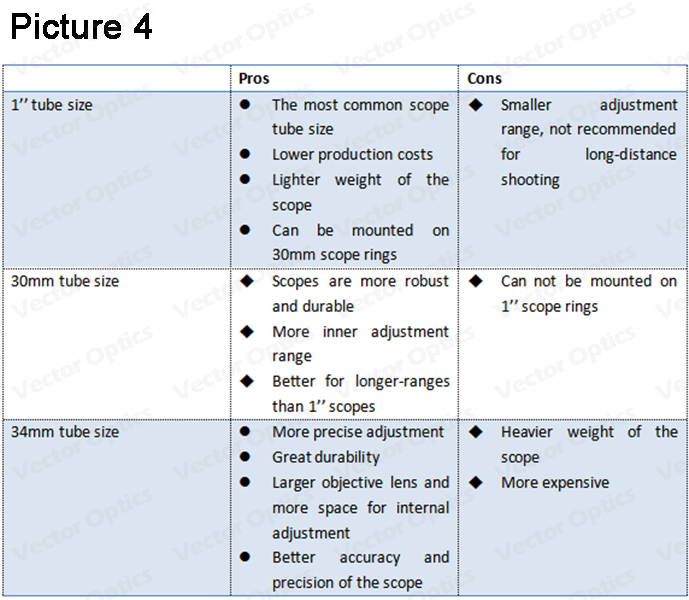Evelyn: Stephen, I noticed that scope manufacturers usually provide different tube sizes for scopes, does scope tube size matter? How to choose among different tube sizes?
Stephen: Good question! First of all, do you know what is the scope tube size and how is it measured?
Evelyn: Yes, the scope tube size is the diameter of the main tube, so if the main tube’s diameter is 30mm, then the scope tube size is 30mm. (picture 1)

Stephen: That’s correct. There are three major scope tube sizes on the market: 1’’(25.4mm), 30mm and 34mm.
Evelyn: If the scope has a larger tube size, does that mean its light transmission rate is higher?
Stephen: That’s a common misconception. Larger main tubes do let in more light, but the changes are minor. What really affect light transmission are the quality of optical glasses , the coatings of scope lens, the size of the objective lenses and the inside optical system.
Evelyn: I see, so what factors do larger main tubes affect?
Stephen: Larger tube size means larger space to fit all of the internal components, which results to greater internal adjustments, making the scope more suitable for long range shooting and target shooting. Check out picture 2 for reference.

Evelyn: Okay, does that mean the larger tube size is, the better the scope performs?
Stephen: No, the tube size is not the only thing to consider when choosing riflescopes, different shooters have their own preference based on their shooting scenarios and habits. Let's first take a deep dive into the pros and cons of the three major scope tube sizes and the corresponding shooting scenarios, and then you will see.

Evelyn: Yes! I’m all ears!
Stephen: First, of the three major scope tube sizes, the 1’’(25.4mm) tube size is very common due to the lower production costs and the lighter weight of the scope. However, the adjustment range is relatively smaller, long-distance shooters may max out the range and need to use a scope base to add more adjustment range. If you are shooting close to medium distances, for example, from 50 to 300 yards, and you care more about the compact size and weight of the scope rather than adjustment, then 1’’(25.4mm) scopes are a good choice.
Evelyn: So the pros and cons of 1’’(25.4mm) tube size are as follows:
Pros:
Very common scope tube size
Lower production costs
Lighter weight of the scope
Cons:
limited internal space leads to smaller adjustment range
Stephen:Correct! Now let’s move on to the 30mm tube size. The 30mm scope tube size is gaining growing popularity nowadays. Compared with the 1’’(25.4mm) scope main tube size, it has a thicker outer body, which means that the 30mm scopes are more robust and durable. The larger tube size also means more inner adjustment range as there’s more space for inner lens assembly, making it fit longer ranges than 1’’(25.4mm) scopes. The downside is that 30mm scopes are relatively heavier and larger compared to 1’’(25.4mm) scopes.
Evelyn:Got it, so the pros and cons of 30mm tube size are as follows:
Pros:
Scopes are more robust and durable
More inner adjustment range
Better for longer-ranges than 1’’ scopes
Cons:
Scopes are relatively heavier and larger compared to 1’’(25.4mm) ones
Stephen: Good! Now let’s talk about the 34mm tube size. First, the greater diameter means oversized elevation and windage turrets, so generally speaking, the adjustment can be produced more precisely; second, 34mm tube scopes have even thicker outer body, with great durability; besides, a larger scope tube can accommodate a larger objective lens and more space for internal adjustment, which allows larger magnification lens and better movement of the reticle, so the accuracy and precision of the scope is increased. Shooters can also find it easier to compensate bullet drop as 34mm main tube scopes have more room for the elevation adjustment. However, the 34mm tube scopes are usually heavier, which could be a downside in shooting, and the price is relatively higher.
Evelyn: I see, so the pros and cons of 34mm tube size are as follows:
Pros:
Adjustments can be more precise
Great durability
Larger objective lens and more space for internal adjustment, better at bullet drop compensation
Better accuracy and precision of the scope
Cons:
Heavier weight of the scope
More expensive

Stephen: Correct, are you clear now about how to choose among different scope tube sizes?
Evelyn: Yes, that depends on what factors do shooters value more and what shooting scenarios they are in. Scope tube size is only one of many factors to consider, and the main change it brings is the internal adjustment range. A 1’’(25.4mm) scope tube is enough if shooters are not shooting at long distances; for long-range shooting, either 30mm or 34mm scope tube is good. If shooters want a nice scope with great precision and accuracy, then go for scopes with larger main tube size like 34mm ones.
Stephen: Yes, you’ve learned a lot today! In general, choose a scope that best fits all your needs, the scope tube size is just one indicator.
Evelyn: Thanks!
Join our Facebook community to know more about Vector Optics!
